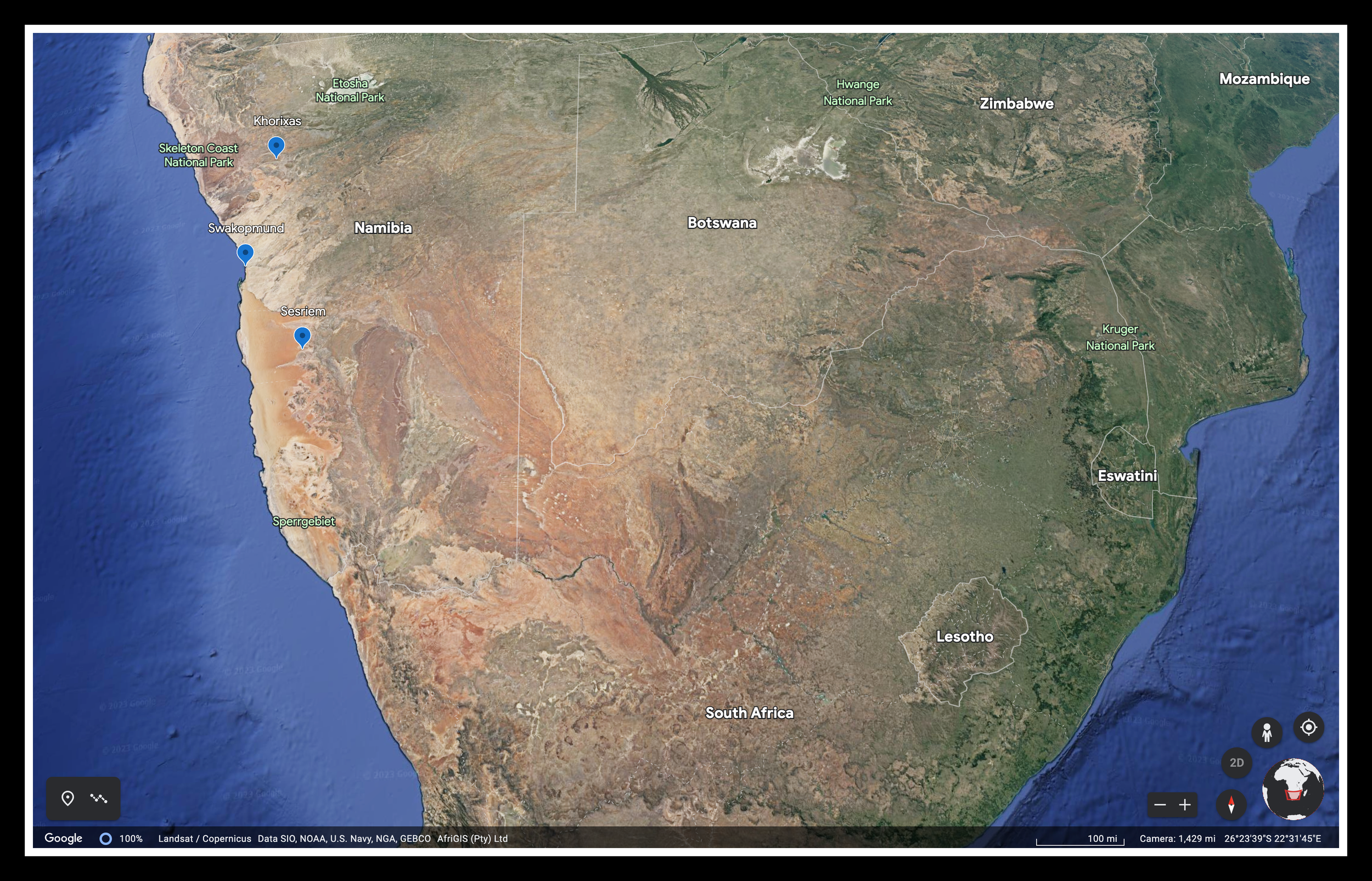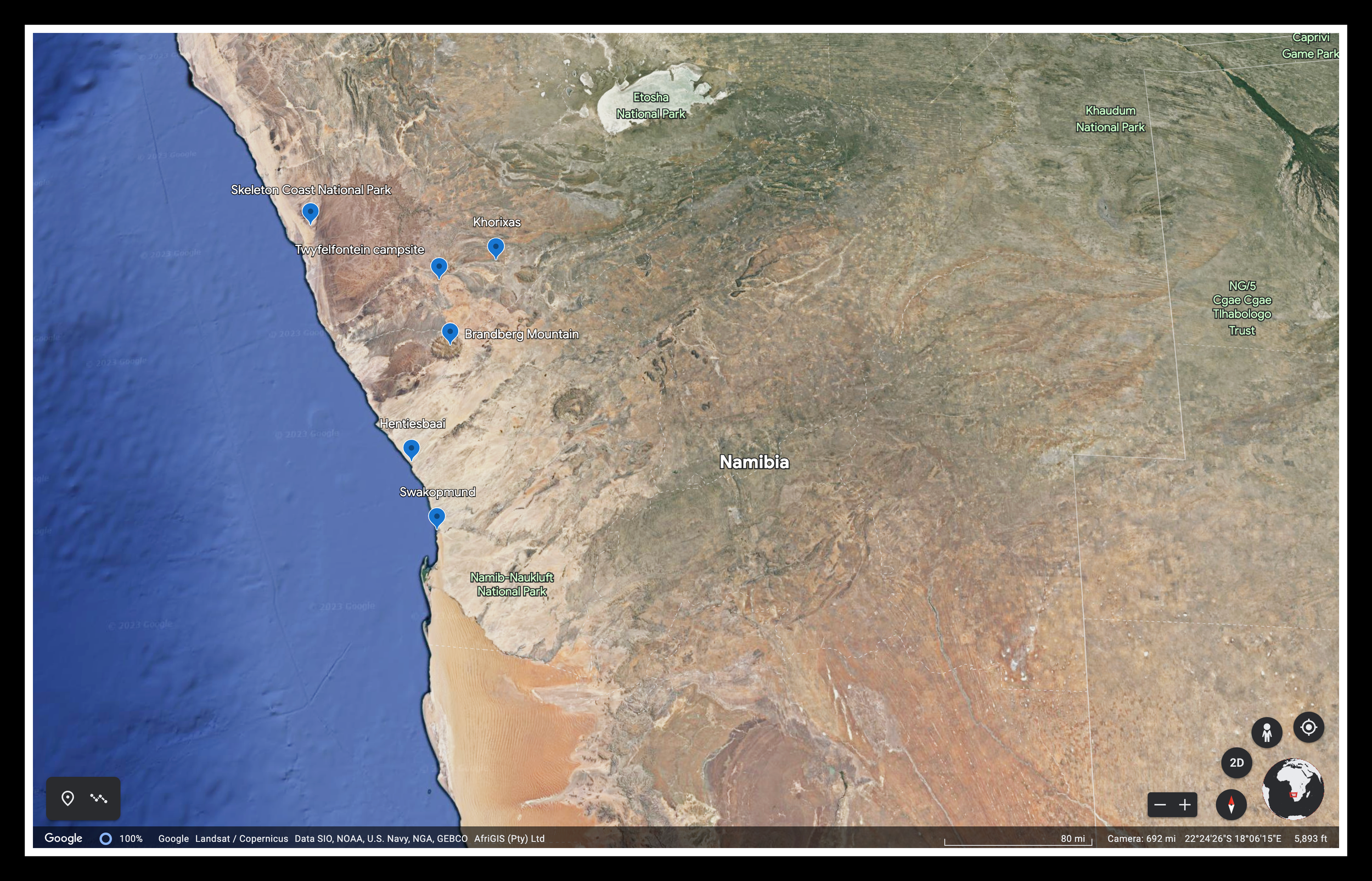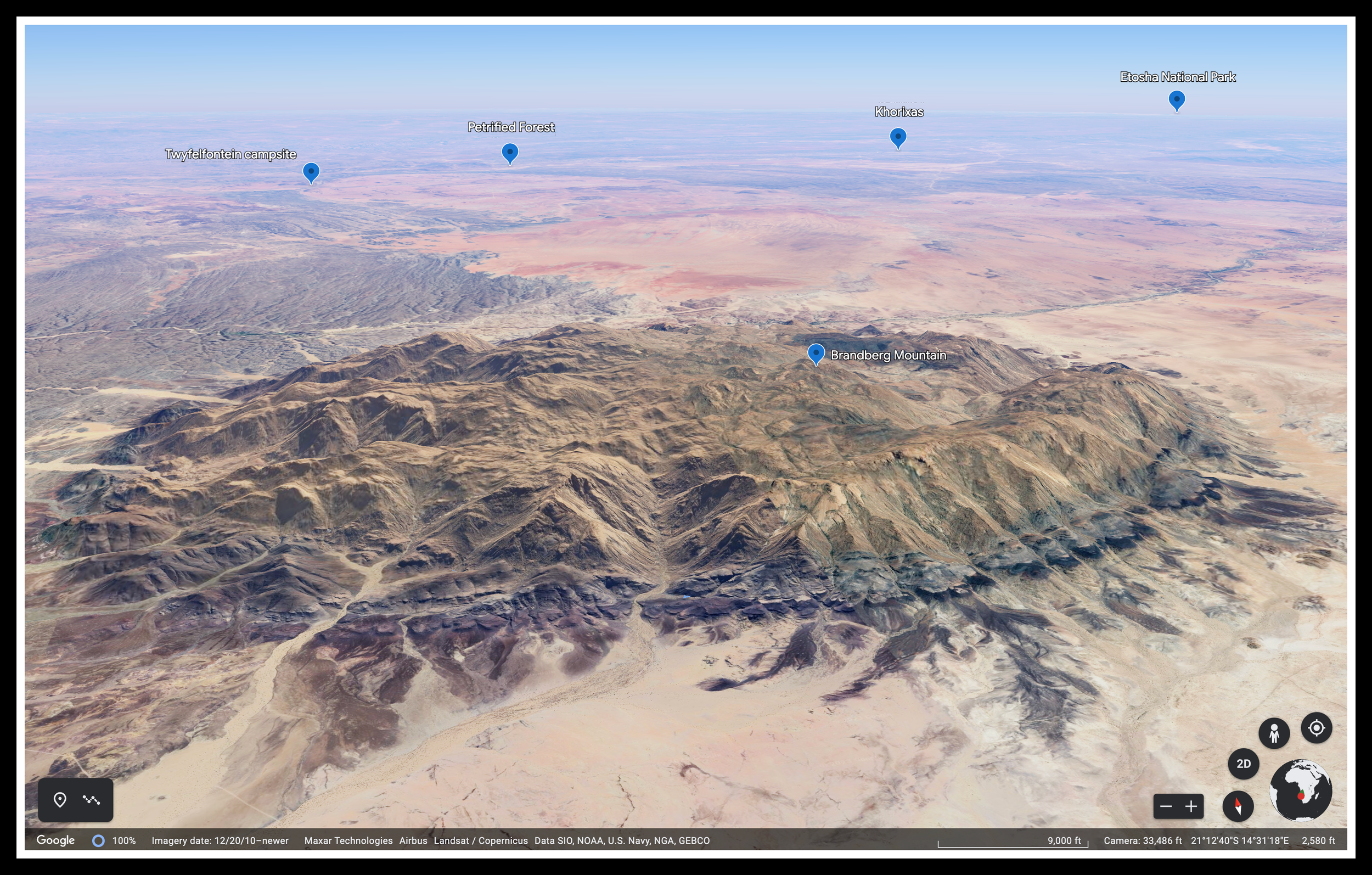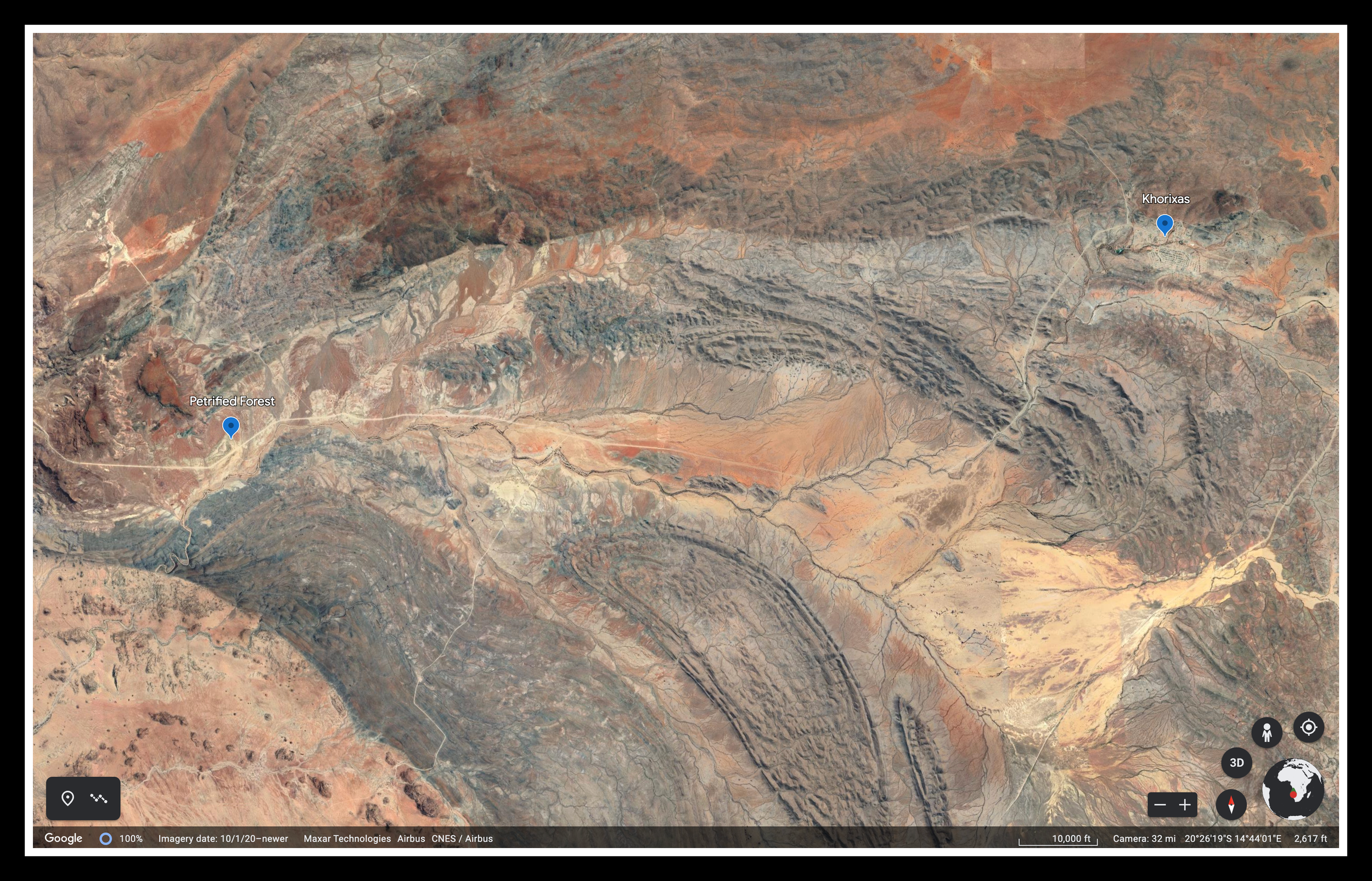212 - Uber German & A Few Clicks (Erongo Province, Namibia)
“MORE GERMAN THAN GERMANY.” That’s how the Lonely Planet described Swakopmund. Sooo… on the desert coast of a Southern African country, you have a mixture of German-Namibian locals, German ex-pats, and German tourists. Yes, that’s bizarre. Good luck reminding yourself where the hell you are. We spent two nights revitalizing, reaping the decadent comforts of bed sleep. I also spent waaay too much time wrangling with Avis. They do try harder…. to exasperate the shit out of you!
Why Germans? In 1884, Namibia became a German colony (German South West Africa) as a counter to growing British hegemony in the region. The locals were pissed from the start. Two tribes, the Herero and Namaqua, mounted a fierce rebellion, resulting in the first genocide of the 20th century (1904 to 1908). Half the Namaqua and approximately eighty percent of the Herero were exterminated. Yikes.
After World War I, the Germans lost Namibia… to South Africa. For the next seventy-five years, it was an extension of SA, bequeathed all the benefits of apartheid. It gained its freedom on March 21, 1990, but Namibia still depends on South Africa economically.
Wonder why Namibia has such vast swaths of nothingness? It’s a country half the size of Alaska with a population of 2.1 million. Density-wise, it’s second only to Mongolia. Outside metropolitan areas, there ain’t a whole lot of folks. If you ever need an escape from humanity, Namibia is a prime candidate.
Swakop didn’t tickle our fancy. It’s the most touristed area in Namibia, so it doesn’t take a psyche major to understand my aversion. Sure, it’s the adventure capital, but that title is more dubious by the year… and more expensive.
We departed under a gray skies and a drizzle. Outside town, we slowed our pace to avoid mowing down marathon runners. I suppose if you’re going to run a marathon in the desert, a cool, rainy day is bliss. The race was sponsored by a uranium mine (Rossing, i.e. Rio Tinto). Why did that feel wrong to me?
We went north up the coast and, I gotta tell ya, there was a shitload of desolate forlornness about the place… shocker. If you told me the final scenes of “The Road” were shot there, I’d believe it, though it almost felt too authentic to be real. (The sequence was shot on the coast of Lake Erie). As if to emphasize the mood, you’ll find the decaying remains of a dilapidated ship decorating the “set.” One year after Armageddon…
We considered exploring the Skeleton Coast but declined for a few reasons. We’d read conflicting reports about permit requirements and were unsure where to acquire one. Second, lodging was an issue. We had our tent but weren’t quite ready to take the training wheels off. Third, the locals we questioned all had the same answer, “Why would you want to do that?” And last but not least, it was reportedly not Spark-friendly terrain. We attempted to exchange the Spark for a 4WD Toyota Hilux, but Avis shit all over that notion. Besides setting us back two kidneys and a liver, it would’ve fomented confusion on a biblical scale. (For Avis, not us). And yet, I have the distinct feeling we missed something remarkable, an experience well worth the hassle. Poop.
At Henties Bay, our compass turned inland northeast toward Damaraland, where wild elephants were rumored to roam the landscape. Alas, we weren’t fortunate enough to cross their path. On to the White Lady of Brandberg. The “White Lady” refers to a figure in a rock painting on an overhang inside Brandberg Mountain. There’s an ongoing controversy over the origins of its creators. (Isn’t there always?) Originally thought to be of Phoenician authorship (as in Mediterranean), it’s now generally agreed to be the work of local bushmen (i.e. San). It’s probably not a lady at all, but a San boy covered in white clay as part of an initiation ceremony. We never saw it. At the entrance, we concluded it wasn’t worth the forty-five-minute walk to the cave under the midday sun. Instead, we ate peanut butter and jelly sandwiches and stared at a lizard. Super.
We were equally unsuccessful at reaching a rest camp in Twyfelfontein, a UNESCO site renowned for extensive rock art galleries. After crossing a particularly iffy stretch, we threw in the towel when Sparky balked at an ominous patch of sand and water. Foiled again.
On our way out of Twyfelfontein, we did have the pleasure of stopping by the local petrified forest near Khorixas. As a child, the term “petrified forest” conjured up visions of ominous-looking stone trees standing upright on piles of ash in a normal forest configuration. In my imagination, there could’ve been ogres and demons living inside. I enjoy visiting such places, but I’m always a teensy-weensy disappointed by the reality.
Still, the reality is stupefying. When I consider the process by which minerals replace all the organic elements of a tree over time (it can happen in less than one hundred years), my mind is boggled. We saw trees that were not only hundreds of millions of years old, but had originated somewhere in present-day Congo-Brazzaville. Um, what?
The forest was fascinating, but it was our Damaran female guide who stole the show. She demonstrated her native language (Khoekhoe), comprised of click consonants. Hers is a four-click variant, but other tribes have their own versions with seven or eleven clicks. The best part? They can’t necessarily understand each other. Amazing.
That day turned into another driving marathon. We had not intended to drive from Swakopmund to Etosha National Park, but that’s how the cookie crumbled. A late arrival forced us to spend the first night outside the park, close to the gate. We found a tented camp that was quaint but a tad overpriced. The owner was nice enough, though upon discovering our nationality, asked us if we were hunters. Hunters? I guess a disproportionate amount of Americans come to Namibia to kill shit on private reserves, at least in his experience. That’s nice.
Courtesy of Sola Gratia Media Production
“No: it’s a word I like to use, but not to hear. Yet somehow, I kept hearing it over, and over, and over again. Can I stop along the road, as long as I promise not to fill my pockets full of diamonds? No. Can I go on a tour of your uranium mine? No. Can I visit the Northern Skeleton Coast to see those awesome desert dwelling elephants you’re hiding up there? No. Okay, technically the last answer was yes, but it costs something like 3K, so it might as well be no. Are you sure I can’t buy this bottle of wine on a Sunday? Yes. See, that yes is really a no. No. No. No. No.
In fact, it wasn’t just Namibia — I received a whole lot of “no’s” everywhere I went. Can I have a visa for Libya? No. Can I access my funds? No. Can I sleep on the bus? No. Can you leave me alone? Definitely not. I heard “no” more in six months than in my entire twenty-six years combined. I’m not sure what that says about me. Perhaps the universe was trying to teach me a lesson? Your guess is as good as mine.
Our next stop was the seaside town of Swakopmund. The area is said to be “More German, than Germany.” Lots of bakeries, pubs, and little shops lined the streets. Strudels, steins, sausages — you name it, they’ve got it. It’s easy to forget where you are. Maybe it’s just me, but I can’t imagine traveling five-thousand miles to vacation in an area that reminds me of home. You can speak the same language, eat the same food, and buy the same little handicrafts without leaving your country. Chances are you can probably run into your neighbors too. Save your money, my friends. Save your money.
Along the way, we took a little detour to inquire about a specific rock painting called “The White Lady,” located within Brandberg Mountain. We pretty much lost our motivation when we arrived at the trail-head, though. The sun was working overtime, we were told a guide was required, and to be honest, we became far more interested in the lizards lurking about. Lazy? Perhaps. It turns out there is quite the controversy surrounding this painting, as it went misinterpreted for years. The “White Lady” in the painting isn’t even a lady… he’s a medicine man. Maybe.”
Leslie Peralta, “The Little Punto That Could” — Soledad: Notes From My Travels














